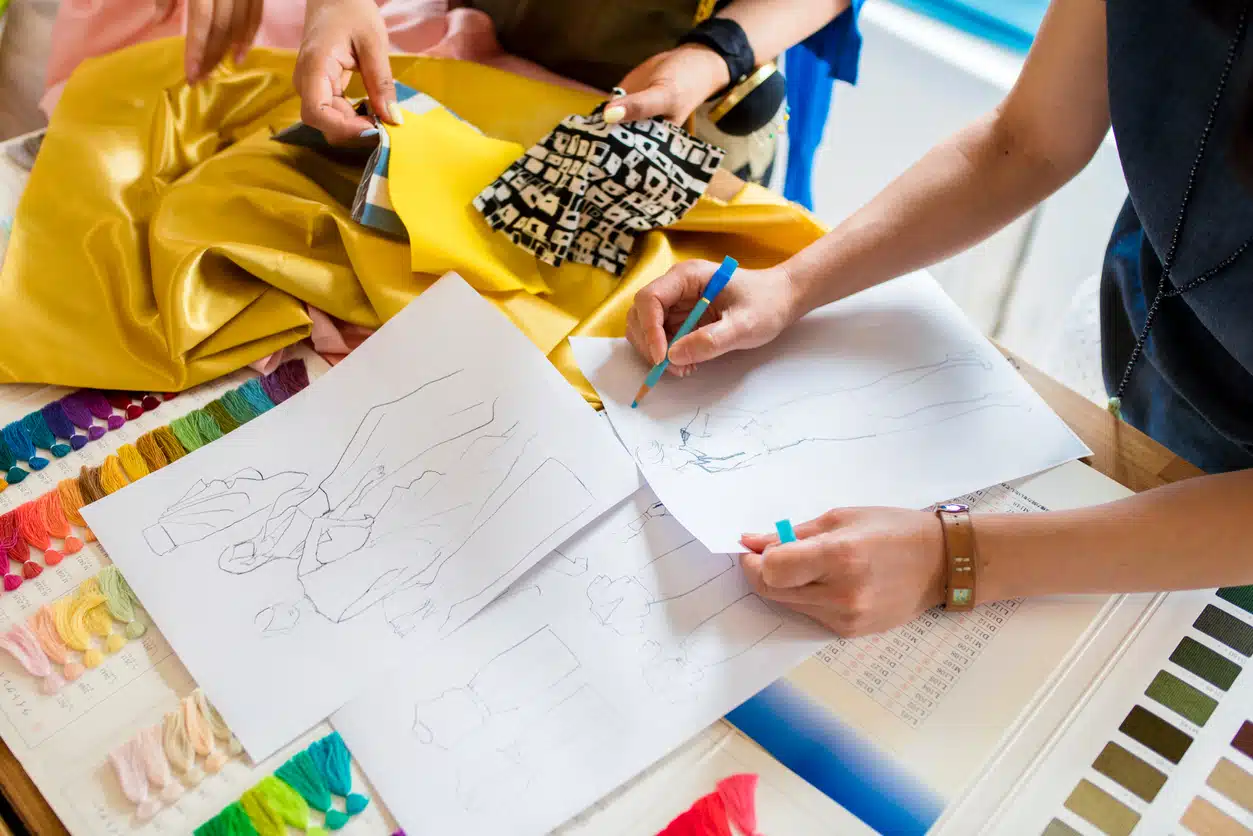As consumer preferences increasingly lean toward unique, handcrafted products, the sewing industry is experiencing a significant revival. This resurgence in sewing isn’t a fad; it reflects a profound transformation in consumer choices. Whether you aspire to be a fashion designer, a home decorator, or a craft enthusiast, the sewing industry boasts a broad spectrum of roles and niches where skilled sewists can flourish.
Within this exciting landscape, sewists can turn their passion for sewing into a viable career. From launching your own business to offering alteration and tailoring services, the avenues to success are as varied as the stitches on a well-crafted garment.
Choosing a Career Path in the Textile or Fashion Industry
There’s no one way to enter the world of professional sewing. For those inclined towards the industrial aspect, factory and manufacturing roles involving large-scale sewing machines are an option. However, if you prefer more personalized or creative avenues, there are several other opportunities to explore.
Start as a Seamster or Seamstress
Consider working with a professional tailor, where your skills will be put to use altering clothing for local clients. Alternatively, assisting a local designer or crafter with their projects can be rewarding. Another option is becoming the lead sewist in a local theater’s costume department.
Run Your Own Sewing Business
On the other hand, if you value independence, you can venture into entrepreneurship. This entails starting your own sewing business, where you can specialize in crafting custom pieces, providing tailoring and alteration services, or creating items for sale on platforms like Etsy. Working for yourself allows you to have some more freedom and creativity, but also responsibility and planning.
Analyze Your Strengths
But if you have a multitude of options to choose from, how do you know which one you’re well-suited for? Assessing your skills, knowledge, and preferences is essential before filling out a job application. You want to be sure that your professional position aligns with your pre-existing strengths; otherwise, you may struggle and become disheartened.
For example, if you regularly sew intricate costumes for yourself and your family around Halloween, you may be well-matched for a job in a costume department. If you like to work at your own pace and design your stuffed animals and toys, the independence of being a small shop owner may appeal to you. Use your existing passions and talents as inspiration to explore specialization within the sewing industry.

Tailoring Education and Training
Of course, if there are gaps in your sewing knowledge, you can still find a specialized job that interests and excites you. All you need to do is seek a little supplemental training.
To begin, consider seeking sewing classes or courses near you that align with your desired career trajectory. Local community colleges, vocational schools, and sewing studios often offer classes ranging from basic sewing techniques to advanced tailoring and patternmaking. These educational opportunities can provide you with a solid foundation and help you refine your skills. Many beginner sewists find it helpful to have a teacher in the room with them as they learn, giving them real-time advice and feedback.
Online courses have also become an invaluable resource for aspiring sewists. Programs like Skillshare and Creative Bug offer classes for sewists of all levels, often centered around a particular pattern or skill set. You can also seek out professional sewists on YouTube and sew along with them as they tackle complex or intricate patterns. If you’re a self-paced learner and learn best by doing something independently, you may thrive with online classes and tutorials.
However, you can take all the classes in the world and not see your skill set grow if you’re not practicing what you learn. To become a better sewist, you must keep sewing – even when you make mistakes, struggle with a new technique, or feel defeated by a particular pattern. Keep challenging yourself as a crafter and designer, and your skills will grow alongside you.
Finally, one of the best ways to hone your sewing skills is to interact with a community of sewists. Networking is pivotal in any profession, and the sewing community is no exception. Connect with fellow sewists, designers, and potential clients through sewing communities and forums, both online and in your local area. Engaging with others who share your passion can provide valuable insights, mentorship opportunities, and collaborations that can propel your career forward.
Build a Sewing Portfolio
Like any other creative career, your portfolio is your greatest asset when applying for sewing jobs. Building a fashion portfolio takes time, planning, and purposeful curation of your best projects – but once it’s together, you can show off your most significant skills at a glance. Make sure you have both physical and digital versions of your portfolio; you can set up a blog or website to host your portfolio or use a social media site like Instagram or Tumblr to document your creations.
Start by meticulously documenting your sewing projects as you make them. This documentation should go beyond mere descriptions and extend to a comprehensive collection of photographs and videos. High-quality images that capture the details of your work, such as intricate stitching, fine finishing, and impeccable fit, are invaluable. Videos that showcase your sewing process, from patternmaking to the final garment, can provide a more in-depth look into your craftsmanship.
A successful sewing portfolio should also emphasize versatility. Showcase various projects that exemplify your adaptability across different sewing styles and techniques. Whether you specialize in crafting costumes, plus-sized fashion, bridal wear, or sustainable fashion, your portfolio should reflect your proficiency in various niches within the sewing industry. This versatility broadens your appeal and illustrates your capacity to tackle a wide array of sewing challenges.
Finally, curate your portfolio to underscore your unique skills and niche. Highlight projects that showcase your specialty and passion within the sewing world. If you excel in creating historically accurate costumes, include examples of such work. If your forte is crafting exquisite plus-sized couture, feature garments that exemplify your expertise in this area. Showcasing your existing skills in your portfolio will help you find the people who need your particular skill set.

Obtain Necessary Tools and Equipment
But what is a sewist without her sewing machine? (and pressing foot, cutting mat, bobbin holder, fabric scraps, and…well, you know what we mean). Maintaining a professional workspace is integral to your success as a working sewist.
The types of sewing projects you plan to undertake will significantly influence your needs. For instance, if you’re focusing on garment sewing, a reliable sewing machine, quality scissors, measuring tools, and an iron are fundamental necessities. A rotary cutter, cutting tables, and specialized rulers are crucial if you specialize in quilting. Make a list of the essentials you need to serve as a guideline when assembling your toolkit.
As you progress in your sewing career, you may need to upgrade your equipment. While it’s wise to start with budget-friendly options when you’re just beginning, consider investing in higher-quality tools and machinery as you gain experience. Upgrading can improve precision, efficiency, and overall craftsmanship, enhancing your reputation and opening up new opportunities.
Consider renting when you encounter specialized projects or require equipment beyond your current budget. Renting equipment for short-term projects can be practical, allowing you to take on unique challenges without committing to a significant purchase. You can often find machinery lending libraries through your local library, a maker space, a local community college, or a local crafts and fabric store.
Finally, you need a space that makes it enjoyable to work all day! Creating an ergonomic sewing workspace is crucial for your comfort and productivity. Invest in ergonomic sewing furniture and consider the layout of your sewing room. Properly designed storage, cutting tables, and equipment organization can help streamline your workflow and reduce strain. A well-organized and functional sewing space enhances your efficiency and conveys professionalism to potential clients and employers.
Gaining Experience as a Sewist
Gaining practical experience is vital to building a thriving sewing career. Volunteering for sewing projects within your community can be an excellent starting point. Joining community theater groups, assisting with school or church plays, or contributing to local events can provide hands-on experience crafting costumes and working with different fabrics. These opportunities help you refine your sewing skills and introduce you to potential clients and collaborators.
Taking on small freelance sewing gigs is another effective way to accumulate experience. Look for freelance sewing jobs in your local area or online platforms, such as offering alterations, creating custom garments, or sewing home decor items. These freelance projects expand your portfolio and establish your reputation as a reliable and skilled sewist.
How to Find Sewing Jobs Near You
To discover sewing jobs nearby, focus on local networking and online resources. Attend events, workshops, and classes with your local sewing community. Join physical and virtual sewing or craft groups to connect with fellow sewists, designers, and potential clients. These community connections often lead to insights about job openings and collaboration opportunities.
Additionally, tap into online job portals and freelance platforms that allow you to filter listings by location. Popular websites such as Indeed, LinkedIn, and local job boards frequently feature sewing-related job opportunities. You can quickly identify sewing jobs nearby by specifying your location in your search.
Utilize social media platforms, like local Facebook groups or sewing-related hashtags on Instagram and Twitter, to stay informed about job openings and connect with clients. Posting your skills and availability on social media profiles can also help local clients find you. Finally, inquire with local community centers, schools, and churches, as they may host sewing events or be aware of organizations seeking sewing assistance within your community, such as school theater productions or charitable initiatives.

Starting Your Own Sewing Business
Starting your sewing business can be rewarding, but it requires careful planning. First, define your niche within the sewing industry, whether custom clothing, alterations, or crafting unique items. Create a business plan that outlines your services, pricing, and target audience.
Before launching your sewing business, honestly assessing your skills and capabilities is crucial. Ensure you have the equipment and materials to meet client demands and deliver high-quality work. Establish clear pricing structures and policies to manage client expectations and protect your time and resources.
Moreover, take the time to research your local market and competition to identify opportunities and areas where you can excel. Finally, providing excellent customer service and marketing your services effectively is critical to building a solid reputation and a thriving sewing business.
Pursue Your Passion in Comfort
In conclusion, pursuing a career in sewing opens up a world of opportunities. The industry is being revitalized as we speak, as consumers become increasingly aware of where their clothes and handmade goods come from. Whether you work for others or start your own sewing business, careful planning and dedication will pave the way for a fulfilling and successful sewing career.
Elevate your sewing experience with Arrow Sewing’s ergonomic sewing furniture, including chairs, cabinets, and storage systems. Whether you’re already a professional or just a passionate hobbyist, Arrow Sewing’s ergonomic furniture transforms your sewing space into a haven of creativity and efficiency. Explore our collection today and redefine how you create – your passion deserves it!
